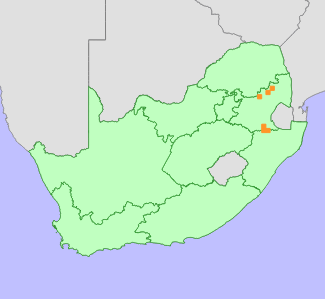|
Scientific Name | Aloe modesta Reynolds |
Higher Classification | Monocotyledons |
Family | ASPHODELACEAE |
National Status |
Status and Criteria | Vulnerable B1ab(iii)+2ab(iii) |
Assessment Date | 2019/11/12 |
Assessor(s) | L. von Staden, M. Lötter & D. McKenzie |
Justification | Aloe modesta is a rare species known from only a few, isolated subpopulations. It has a restricted range, with an extent of occurrence of 12 230 km², and an estimated area of occupancy of 104-112 km². It is known from five to ten locations and continue to decline due to ongoing habitat loss and degradation. |
Distribution |
Endemism | South African endemic |
Provincial distribution | KwaZulu-Natal, Mpumalanga |
Range | This species occurs in scattered, isolated subpopulations across the Mpumalanga Highveld, from Dullstroom to Graskop, and southwards to Barberton and Wakkerstroom. |
Habitat and Ecology |
Major system | Terrestrial |
Major habitats | Steenkampsberg Montane Grassland, Wakkerstroom Montane Grassland, Long Tom Pass Montane Grassland, Paulpietersburg Moist Grassland |
Description | It occurs in seasonally moist, high altitude montane grasslands, 1800-2300 m. |
Threats |
| Much of Aloe modesta's habitat along the Mpumalanga escarpment edge was lost to commercial timber plantations in the past, and two remaining subpopulations in this area occur on isolated fragments among plantations. Plantations are no longer expanding, and therefore habitat loss is no longer a significant threat. One of these subpopulations is however threatened by overgrazing from livestock, as well as competition from alien invasive plants.
Near Dullstroom, its habitat is well protected, however, small clumps of plants occurring outside protected areas are also threatened by grazing and competition from alien invasive plants.
Most Wakkerstroom records are from the KwaMandlangapisi/Mabola Protected Environment, where the most severe threat is from coal mining. A mining application was authorised within this protected area, and the matter is currently being decided by the courts. The protected environment consists of several individually privately owned farms. There is light grazing by livestock on parts of this protected environment, and some of it is invaded by wattles and other alien invasive species. This subpopulation extends into the adjacent Pongola Bush Nature Reserve in KwaZulu-Natal, where there are no severe threats. |
Population |
A. modesta is rarely recorded mainly because it is inconspicuous unless in flower and the flowering season is very short (February-March), and therefore it is easily overlooked. Previously it was known from only two very small subpopulations, but subsequent field surveys recorded three more, and it was found to be relatively common in the Wakkerstroom area. A continuing decline is inferred from ongoing habitat loss and degradation.
|
Population trend | Decreasing |
Assessment History |
Taxon assessed |
Status and Criteria |
Citation/Red List version | | Aloe modesta Reynolds | VU B2ab(ii,iii,iv,v) | Raimondo et al. (2009) | | Aloe modesta Reynolds | Data Deficient | Victor (2002) | | Aloe modesta Reynolds | Data Deficient | Scott-Shaw (1999) | | Aloe modesta Reynolds | Insufficiently Known | Hilton-Taylor (1996) | |
Bibliography |
Craib, C. 2005. Grass Aloes in the South African Veld. Umdaus Press, Hatfield.
Hilton-Taylor, C. 1996. Red data list of southern African plants. Strelitzia 4. South African National Botanical Institute, Pretoria.
Raimondo, D., von Staden, L., Foden, W., Victor, J.E., Helme, N.A., Turner, R.C., Kamundi, D.A. and Manyama, P.A. 2009. Red List of South African Plants. Strelitzia 25. South African National Biodiversity Institute, Pretoria.
Scott-Shaw, C.R. 1999. Rare and threatened plants of KwaZulu-Natal and neighbouring regions. KwaZulu-Natal Nature Conservation Service, Pietermaritzburg.
Smith, G.F., Steyn, E.M.A., Victor, J.E., Crouch, N.R., Golding, J.S. and Hilton-Taylor, C. 2000. Aloaceae: The conservation status of Aloe in South Africa: an updated synopsis. Bothalia 30(2):206-211.
Van Wyk, B.-E. and Smith, G. 1996. Guide to the aloes of South Africa. Briza Publications, Pretoria.
Victor, J.E. 2002. South Africa. In: J.S. Golding (ed), Southern African plant Red Data Lists. Southern African Botanical Diversity Network Report 14 (pp. 93-120), SABONET, Pretoria.
|
Citation |
| von Staden, L., Lötter, M. & McKenzie, D. 2019. Aloe modesta Reynolds. National Assessment: Red List of South African Plants version . Accessed on 2025/05/19 |
 Comment on this assessment
Comment on this assessment


